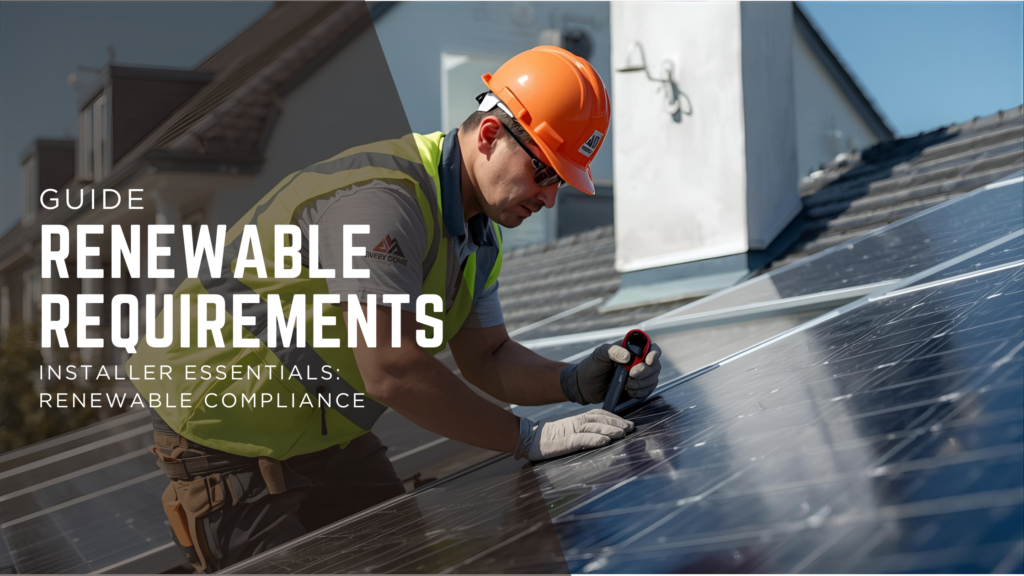Energy bills are higher than ever. Homeowners are looking for cheaper, greener ways to heat and power their homes. And the Government is putting billions into schemes to make it happen.
That means one thing for you: more work — if you’re ready to grab it.
Whether you’re a roofer, glazier, heating engineer, electrician, plumber or builder, your skills are already in demand in the renewable market. The only question is: how do you get started?
Why Diversify?
Relying on just one type of work is risky. Markets change, demand shifts, and prices rise and fall. Smart businesses diversify — not to abandon what they do well, but to add new income streams and spread that risk.
For tradespeople, renewables offer exactly that. It’s not about giving up glazing, roofing, electrics or plumbing — it’s about adding another profitable line of work alongside them.
Think of it this way:
If one market slows down, renewables can pick up the slack.
If you’re already on site, you can quote for another job.
If customers trust you with their roof, wiring or heating, they’re more likely to trust you with a renewable upgrade too.
And the demand is real:
260,000+ small-scale renewable installs in 2024 (MCS).
Nearly 60,000 heat pumps installed — a 43% year-on-year jump (MCS).
180,000+ solar PV installs, with battery storage nearing 20,000 (MCS).
5,250+ MCS-certified contractors by early 2025, more than ever before (MCS).
This isn’t just “something new.” It’s a sector with strong demand, government funding, and staying power.
Which Path Suits Your Trade?
You don’t need to reinvent yourself to move into renewables. Most trades already have a natural entry point:
Roofers → Solar PV & battery storage.
Electricians → Solar PV, battery storage, EV chargers.
Heating engineers & plumbers → Heat pumps & biomass boilers.
Glaziers → Energy-efficient windows, insulation partnerships.
General builders → Retrofit coordination & multi-measure projects.
These aren’t hard rules — just logical starting points. Whatever your trade, you already have skills you can adapt.
Two Ways into Renewables
Able-to-Pay Jobs
Not every installer wants the paperwork that comes with government schemes. That’s where able-to-pay jobs come in — privately funded installs where the homeowner pays you directly. Solar panels, batteries, heat pumps and biomass systems are all in demand.
The minimum requirements are light, but the most successful installers add extra credibility:
Insurance Backed Guarantees (IBGs) — not required, but a powerful USP. They prove your work is protected and give customers peace of mind.
Built-in reviews — every IBG you issue through HomePro includes an automatic review request. With 92% of homeowners influenced by reviews, that’s proof that wins more work.
Future-proofing — MCS certification or consumer code membership helps you access finance products and attract savvy customers.
You don’t have to tick these boxes — but if you want to win more jobs, these tools set you apart.
Grant-Funded Jobs
Grant-funded work means government or local authorities cover part (or all) of the cost, making jobs easier to sell and pipelines more reliable.
The trade-off? Stricter requirements. Typically you’ll need:
MCS certification (for technologies like heat pumps, solar, or biomass).
PAS 2030/2035 compliance (retrofit standards).
TrustMark registration.
Consumer code membership (RECC or HIES, which require IBGs).
Not ready to take it all on yourself? Many installers get started by:
Subcontracting under a main scheme provider.
Partnering with local authorities or housing associations.
Starting with smaller programmes while working towards full certification.
👉 For a breakdown of the main government schemes, see our UK Grants Guide.
First Steps to Diversify
Where you begin depends on the path you want to take:
Interested in grant-funded work?
Identify which schemes suit you (ECO4, BUS, GBIS, WHSF).
Check your current accreditations — if you’re missing MCS, TrustMark, or PAS, that’s your starting point.
Find out which councils, housing associations, or suppliers are active in your area.
Leaning towards able-to-pay jobs?
Research local demand for the renewable measure/s you’re interested in.
Consider IBGs as a unique selling point — and let reviews build your reputation.
Think about MCS certification, even if not compulsory — it future-proofs your business.
Still undecided?
Pick one renewable technology you’re interested in.
Explore the training or certification you’d need.
Start small — every step now makes you more competitive later.
Why Work With HomePro
Not every installer can offer Insurance Backed Guarantees — you need to be approved. That’s part of what makes a HomePro membership a unique selling point:
IBGs for both private and funded jobs — meet scheme rules and win able-to-pay work.
Automatic reviews — every IBG includes a review request straight to your customer, giving you proof that homeowners trust.
Ready-to-use documents — contracts, guarantees and templates that can save you hours of admin.
Dedicated Account Manager — real support to help you avoid pitfalls and grow faster.
With HomePro, you’re not just protecting jobs — you’re showing customers you’ve been vetted, approved and backed. That makes renewables safer, simpler, and more sellable.
Ready to get started? Apply for your HomePro membership today.
Disclaimer:
The information on this page is provided for general guidance only. Laws, regulations, and scheme requirements may change over time. We make no guarantee that all the content here is current, complete, or accurate, and we accept no liability for decisions made based on it. It is your responsibility to verify any details with official sources or qualified professionals before acting on them.


